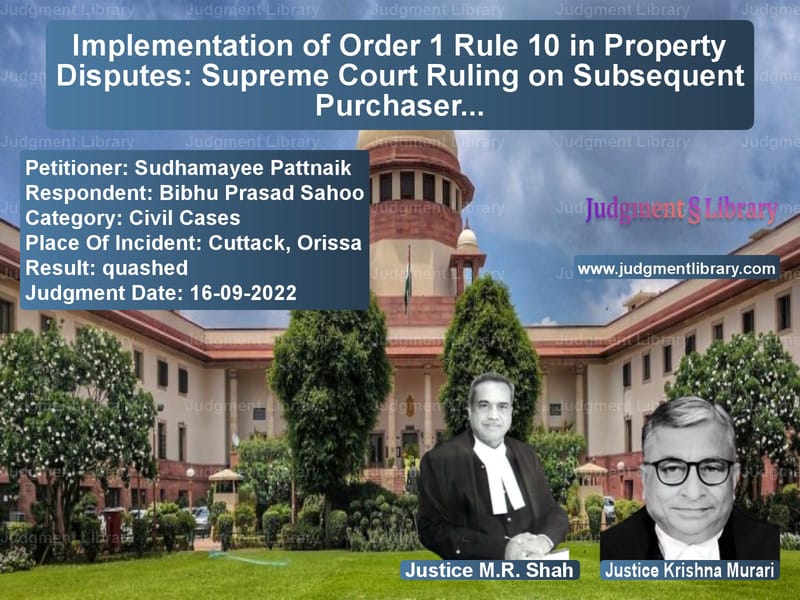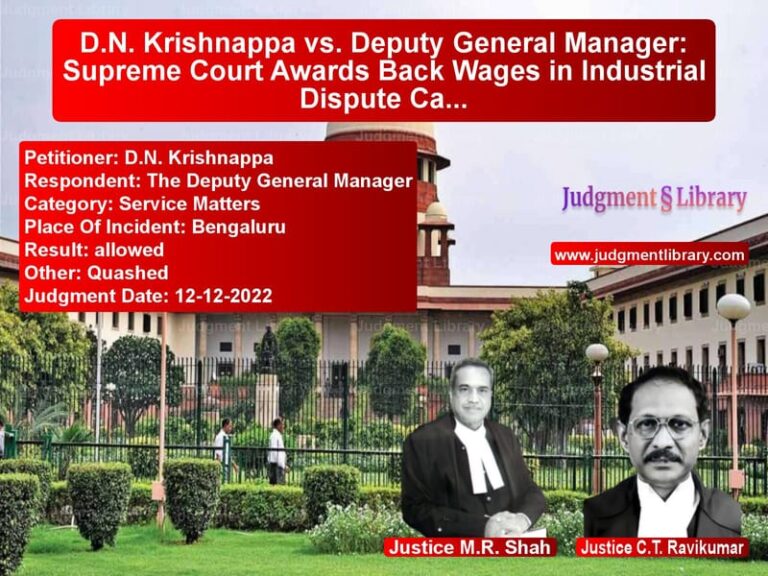Implementation of Order 1 Rule 10 in Property Disputes: Supreme Court Ruling on Subsequent Purchasers
The Supreme Court of India recently ruled on the implementation of Order 1 Rule 10 of the Civil Procedure Code (CPC) in a property dispute case. The appeal was filed by Sudhamayee Pattnaik and others, challenging the decision of the Orissa High Court which had upheld the trial court’s order to implead subsequent purchasers in a suit for declaration, permanent injunction, and recovery of possession. The dispute centered around whether subsequent purchasers, who had acquired property during the pendency of the suit, could be made party defendants in the case without the plaintiffs’ consent.
The case arose from a Civil Suit No. 298/2011 filed by the appellants (Sudhamayee Pattnaik and others) against the original defendants for declaration, possession, and permanent injunction concerning property. After the plaintiffs had closed their evidence, the defendants filed an application under Order 1 Rule 10 of the CPC to implead subsequent purchasers as defendants, arguing that the property had been transferred illegally to these third parties during the pendency of the suit. The trial court allowed the application, and the subsequent purchasers were added as parties to the suit. The appellants challenged this decision in the High Court, but their appeal was dismissed.
Background of the Dispute
The plaintiffs, Sudhamayee Pattnaik and others, instituted the suit for declaration, permanent injunction, and recovery of possession of certain property. During the proceedings, the original defendants filed an application under Order 1 Rule 10 of the CPC to implead the subsequent purchasers of the disputed land as defendants. They claimed that the plaintiffs had illegally transferred parts of the disputed land to individuals named Manasi Sahoo, Bharat Chandra Sahoo, Dhaneswar Sahoo, and Kedarnath Sahoo during the pendency of the suit. The defendants contended that to prevent multiplicity of proceedings and ensure proper adjudication of the case, the subsequent purchasers should be included as defendants.
Read also: https://judgmentlibrary.com/supreme-court-upholds-agreement-to-sell-in-property-dispute/
The plaintiffs opposed the application, arguing that as the dominus litis (the master of the suit), they should have control over who could be impleaded as defendants in their case. They contended that the defendants had no right to file such an application and that the subsequent purchasers should not be included without the plaintiffs’ consent. Despite these objections, the trial court allowed the impleadment of the subsequent purchasers, a decision upheld by the High Court of Orissa.
Petitioner’s Arguments
The appellants, represented by their counsel, argued that the trial court and the High Court had made a grave error by allowing the subsequent purchasers to be impleaded in the case. The appellants contended that the plaintiffs had the exclusive right to determine who could be parties to the suit, and the court should not allow the impleadment of third parties against their will. They emphasized that as per the principle of dominus litis, the plaintiffs should have the final say in whether other parties could join the litigation.
The appellants’ counsel also pointed to the case of *Rahul S. Shah v. Jinendra Kumar Gandhi* (2021) 6 SCC 418, in which the Supreme Court had held that the impleadment of third parties could only occur when it was necessary for the effective adjudication of the suit and when the plaintiffs consented. The appellants argued that the facts in their case were different, and the impleadment of the subsequent purchasers was unnecessary.
Respondent’s Arguments
The respondents, representing the original defendants, argued that the trial court’s decision to implead the subsequent purchasers was correct. They emphasized that the subsequent purchasers had acquired the property during the pendency of the suit, and as such, they had a direct interest in the outcome of the case. The respondents contended that allowing the subsequent purchasers to be made parties to the case was necessary to avoid the risk of multiple litigations regarding the same property.
The respondents’ counsel pointed out that the principle of lis pendens (the rule that no one can acquire property rights during the pendency of a lawsuit) applied to the case, and the subsequent purchasers were bound by the outcome of the dispute. They argued that it was only fair to include the subsequent purchasers as defendants to ensure a just resolution of the matter. The respondents maintained that the trial court’s decision to allow the impleadment was in line with legal principles and would ensure a more efficient adjudication of the case.
Court’s Reasoning
The Supreme Court, in its reasoning, emphasized the principle of dominus litis, which grants the plaintiffs control over the parties in a suit. The Court acknowledged that, in most cases, the plaintiffs have the right to decide who should be impleaded as defendants. However, the Court also recognized that this principle is not absolute, and there are situations where it is necessary for the court to exercise its discretion to add parties to the litigation for the sake of justice and the proper adjudication of the case.
The Court referred to the provisions of Order 1 Rule 10 of the CPC, which allows the court to add parties to a suit if it is necessary for the effective adjudication of the case. The Court noted that in the present case, the subsequent purchasers had acquired the property during the pendency of the suit and had a direct interest in the outcome of the proceedings. The Court observed that without adding the subsequent purchasers, there could be the possibility of conflicting judgments or multiple litigations over the same property, which would not serve the interests of justice.
Moreover, the Court noted that the plaintiffs had not provided a sufficient legal basis for objecting to the impleadment of the subsequent purchasers. While the plaintiffs argued that they had the right to control who could be made parties to the case, the Court found that this right must be balanced with the need to ensure the proper adjudication of the case and avoid unnecessary complications.
Read also: https://judgmentlibrary.com/supreme-court-reduces-compensation-in-medical-negligence-case/
Judgment
The Supreme Court allowed the appeal and quashed the orders of the High Court and the trial court allowing the impleadment of the subsequent purchasers. The Court held that the subsequent purchasers should not have been added as defendants at the request of the original defendants and against the wishes of the plaintiffs. The Court emphasized that the principle of dominus litis should have been respected in this case, and the plaintiffs had the right to control the parties involved in the suit.
However, the Court also made it clear that the plaintiffs, by not allowing the subsequent purchasers to be impleaded, could not later claim that no effective decree could be passed in the case if the counterclaim by the defendants was upheld. The Court observed that if the counterclaim was allowed, the plaintiffs would not be able to contest the absence of the subsequent purchasers as parties to the case, as the property had been transferred during the pendency of the suit.
Conclusion
The Supreme Court’s judgment in this case highlights the delicate balance between the right of plaintiffs to control their lawsuit and the need for effective adjudication of property disputes. The ruling emphasizes that while the principle of dominus litis grants plaintiffs control over the parties to a suit, the court may intervene when necessary to prevent multiplicity of proceedings and ensure the just resolution of the dispute. This case clarifies the application of Order 1 Rule 10 of the CPC and serves as an important precedent for similar cases involving the impleadment of third parties in property disputes.
Petitioner Name: Sudhamayee Pattnaik.Respondent Name: Bibhu Prasad Sahoo.Judgment By: Justice M.R. Shah, Justice Krishna Murari.Place Of Incident: Cuttack, Orissa.Judgment Date: 16-09-2022.
Don’t miss out on the full details! Download the complete judgment in PDF format below and gain valuable insights instantly!
Download Judgment: sudhamayee-pattnaik-vs-bibhu-prasad-sahoo-supreme-court-of-india-judgment-dated-16-09-2022.pdf
Directly Download Judgment: Directly download this Judgment
See all petitions in Contract Disputes
See all petitions in Property Disputes
See all petitions in Landlord-Tenant Disputes
See all petitions in Specific Performance
See all petitions in Damages and Compensation
See all petitions in Judgment by Mukeshkumar Rasikbhai Shah
See all petitions in Judgment by Krishna Murari
See all petitions in Quashed
See all petitions in supreme court of India judgments September 2022
See all petitions in 2022 judgments
See all posts in Civil Cases Category
See all allowed petitions in Civil Cases Category
See all Dismissed petitions in Civil Cases Category
See all partially allowed petitions in Civil Cases Category






